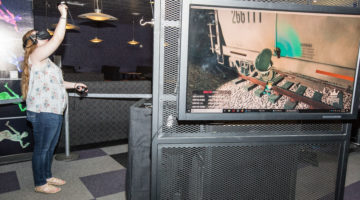Photo illustration by Kaitlin Oki with photo courtesy of BOOKS18/Flickr.com
Students and faculty alike had the opportunity to witness literary history in the making at the Knowledge Center last Tuesday when noted Shakespeare historians met to debate the authorship of “Double Falsehood.”
By Tyler Hersko
Despite all of the dragon-slaying and lightning-blasting thrills that video games such as “The Elder Scrolls V: Skyrim” can provide, I’m rarely able to immerse myself in even the most open-ended of gaming’s virtual worlds.
While the fictional realms of “The Elder Scrolls” franchise and its ilk are nothing short of breathtaking, I’ve never been able to get over the fact that they’re just that: imaginary worlds with no legitimate grounding in reality.
That said, thanks to the Slovokian-based software company Outerra, the lines between the real and virtual worlds have become more blurred than ever. The company’s “Anteworld” tech demo has gained quite a bit of traction over the last few weeks, and with but a brief look at its features, it isn’t hard to see why.
While some games painstakingly recreate large cities or even entire continents, “Anteworld’s” scope is far more ambitious: It’s a simulation of the planet Earth. Literally, “Anteworld” is a virtual realization of our entire world. Imagine traversing a woodland region in “Call of Duty” or the “The Elder Scrolls” series. It’s like those games’ graphics, except you can quite truly go anywhere.
There are, inevitably, more than a few catches, but first, let’s just marvel at the fact that something like this even exists.
“Anteworld” is made possible by the company’s 3D engine, which is simply called “Outerra.” “Outerra” pulls its information from a variety of complex algorithms and real-world satellite data sources to render an exact replica of Earth.
Unsurprisingly, it requires fairly modern computer specs — the minimum requirements include “Nvidia 8xxx” or “ATI 5xxx” graphics cards — to even run. But if you have a computer that can process the data, and an internet connection fast enough to download massive portions of the Earth’s terrain in real time, it’s quite the experience.
In one instance, I traversed Mount Everest. Having found no solace on its wintery peaks, I entered the coordinates for Death Valley, California. After a few moments of data rendering, I was there. Thanks to a simple control scheme and the ability to move as fast as you please, zipping around the world is an unassuming, yet ridiculously entertaining, practice.
The sky is not the limit in “Anteworld.” If you tire of Australia, turn up the speed dial and Superman your way into outer space, then rocket yourself back down elsewhere on the planet.
This may sound like the absolute greatest thing in the history of interactive electronics — and to be fair, it’s certainly one of the most interesting in recent memory — but for the time being, the aforementioned caveats of “Anteworld’s” mean that we’ll have to wait awhile longer for this kind of technology to truly bear fruit.
For starters, “Anteworld” renders the natural world and little else. There are almost no roads, buildings or other man-made entities. As for people and animals, forget about it. While a $15 upgrade from the free demo of “Anteworld” will allow you to place some of these things, those hoping to traverse a fully realized modern world will be more than disappointed. If you were hoping to explore a virtual replica of the University of Nevada, Reno, for example, you’ll come to find that it’s a pretty dull place without all of the pavement or buildings…Or anything.
While the complete lack of direction will quickly turn off those uninterested in virtual spelunking, the power of this kind of technology isn’t going to go unnoticed for much longer. “Anteworld” and the “Outerra” engine are only in their alpha stages, and it’s impossible not to imagine what kind of things could be created with this technology in the near future. The fact that a group of dedicated modders have already created a 1:1 scale of Middle Earth speaks to the engine’s potential.
Imagine playing “Call of Duty.” Except instead of a cramped slaughterhouse, the entire world is your playground. Or think of what strategy games such as “Total War” and “StarCraft” could do with this kind of scope. Or massively multiplayer games like “World of Warcraft.” Or a version of “Minecraft” on steroids.
For most, the “Outerra” engine may currently appear to be nothing more than an oddity, an endlessly impressive interactive version of Google Maps, maybe, but nothing more.
But the potential is most certainly there. Whether or not it takes another few months or a few years, the “Outerra” engine has the potential to singlehandedly become the future of interactive entertainment.
Tyler Hersko can be reached at thersko@unr.edu.













